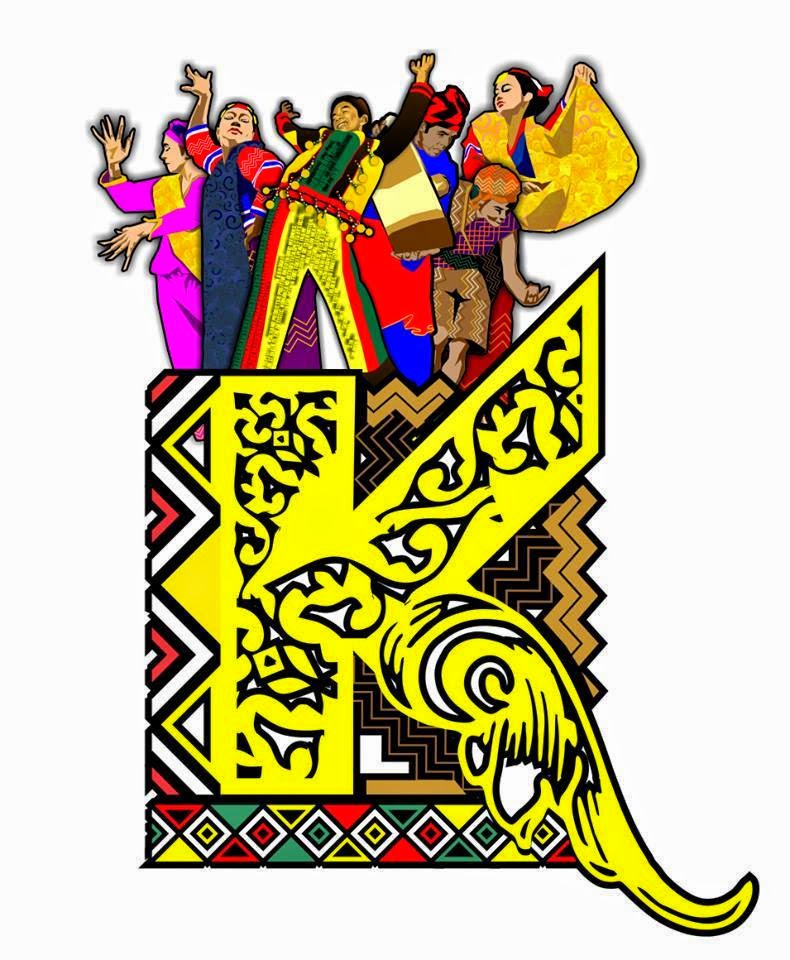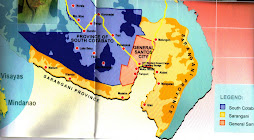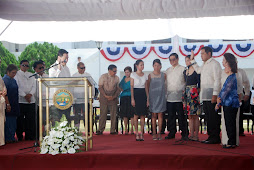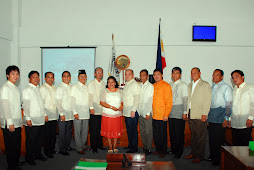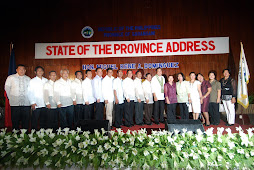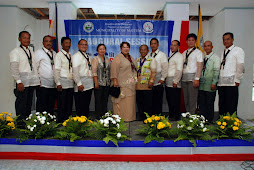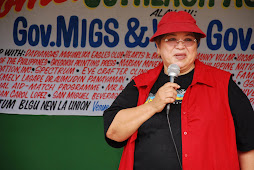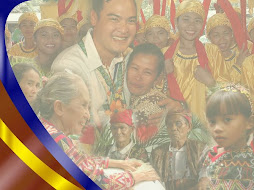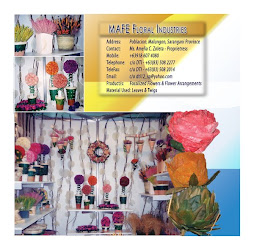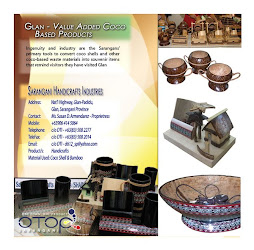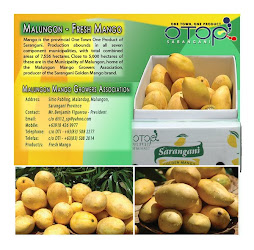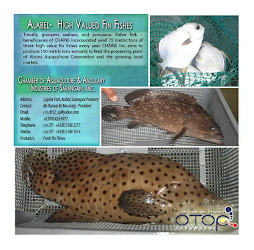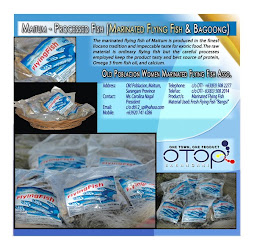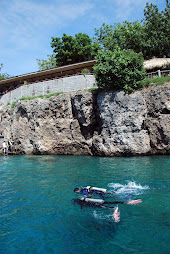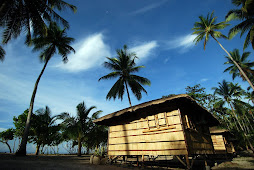 GLAN, Sarangani (October 31, 2010) – Newly-wed couple Tres Besana and Che Bastasa-Besana take a walk at the white-sand shore of Brod Louie Beach Resort following their matrimonial rites in a cool Saturday afternoon, October 30, followed by a dinner at the resort’s reception hall. Brod Louie is among the tens of white-sand beach resorts in Glan frequented by locals and foreign tourists. (Cocoy Sexcion/SARANGANIINFORMATION OFFICE)
GLAN, Sarangani (October 31, 2010) – Newly-wed couple Tres Besana and Che Bastasa-Besana take a walk at the white-sand shore of Brod Louie Beach Resort following their matrimonial rites in a cool Saturday afternoon, October 30, followed by a dinner at the resort’s reception hall. Brod Louie is among the tens of white-sand beach resorts in Glan frequented by locals and foreign tourists. (Cocoy Sexcion/SARANGANIINFORMATION OFFICE)
Sunday, October 31, 2010
Brod Louie Beach Resort wedding
 GLAN, Sarangani (October 31, 2010) – Newly-wed couple Tres Besana and Che Bastasa-Besana take a walk at the white-sand shore of Brod Louie Beach Resort following their matrimonial rites in a cool Saturday afternoon, October 30, followed by a dinner at the resort’s reception hall. Brod Louie is among the tens of white-sand beach resorts in Glan frequented by locals and foreign tourists. (Cocoy Sexcion/SARANGANIINFORMATION OFFICE)
GLAN, Sarangani (October 31, 2010) – Newly-wed couple Tres Besana and Che Bastasa-Besana take a walk at the white-sand shore of Brod Louie Beach Resort following their matrimonial rites in a cool Saturday afternoon, October 30, followed by a dinner at the resort’s reception hall. Brod Louie is among the tens of white-sand beach resorts in Glan frequented by locals and foreign tourists. (Cocoy Sexcion/SARANGANIINFORMATION OFFICE)
Munato 2010 battle of the bands
 GENERAL SANTOS CITY (October 31, 2010) – Award-winning local band No Choice from General Santos City performs at the elimination round of the battle of the bands Friday night, October 29, at J-KRO Acoustic and Resto Bar at Lagao Road, for Sarangani’s 6th Munato Festival comes November 25-27. With the P15,000 grand prize on November 26 final night at the Capitol ground, ten bands will compete playing their original composition, a campaign for peace through songwriting. (CocoySexcion/SARANGANI INFORMATION OFFICE)
GENERAL SANTOS CITY (October 31, 2010) – Award-winning local band No Choice from General Santos City performs at the elimination round of the battle of the bands Friday night, October 29, at J-KRO Acoustic and Resto Bar at Lagao Road, for Sarangani’s 6th Munato Festival comes November 25-27. With the P15,000 grand prize on November 26 final night at the Capitol ground, ten bands will compete playing their original composition, a campaign for peace through songwriting. (CocoySexcion/SARANGANI INFORMATION OFFICE)
Kamoteng Bakal band
 GENERAL SANTOS CITY (October 31, 2010) – Calling themselves Kamoteng Bakal, this band played two of their original compositions at the elimination round of the battle of the bands Friday night, October 29,at J-KRO Acoustic and Resto Bar at Lagao Road, for Sarangani’s 6th Munato Festival comes November 25-27. With the P15,000 grand prize on November 26 final night at the Capitol ground, the ten-band showdown is also Sarangani’s campaign for peace through song writing. (CocoySexcion/SARANGANI INFORMATION OFFICE)
GENERAL SANTOS CITY (October 31, 2010) – Calling themselves Kamoteng Bakal, this band played two of their original compositions at the elimination round of the battle of the bands Friday night, October 29,at J-KRO Acoustic and Resto Bar at Lagao Road, for Sarangani’s 6th Munato Festival comes November 25-27. With the P15,000 grand prize on November 26 final night at the Capitol ground, the ten-band showdown is also Sarangani’s campaign for peace through song writing. (CocoySexcion/SARANGANI INFORMATION OFFICE)
Saturday, October 30, 2010
Lemuhen Performing Arts
 ALABEL, Sarangani (October 30, 2010) – Lemuhen Performing Arts Group dancers from Kiamba town perform at the indigenous peoples thanksgiving day Friday, October 29, at the provincial gym. This Tboli performing arts group is recipient of the School of Living Tradition, a project by the Indigenous Peoples Development Program under the governor’s office. (Cocoy Sexcion/SARANGANI INFORMATION OFFICE)
ALABEL, Sarangani (October 30, 2010) – Lemuhen Performing Arts Group dancers from Kiamba town perform at the indigenous peoples thanksgiving day Friday, October 29, at the provincial gym. This Tboli performing arts group is recipient of the School of Living Tradition, a project by the Indigenous Peoples Development Program under the governor’s office. (Cocoy Sexcion/SARANGANI INFORMATION OFFICE)
Better future for the IPs
 ALABEL, Sarangani (October 30, 2010) – Governor Migs Dominguez gives an inspirational message to tribal elders and participants by providing the younger generation the opportunity to finish their education and become professionals during the indigenous peoples thanksgiving day Friday, October 29, at the provincial gym. (Cocoy Sexcion/SARANGANI INFORMATION OFFICE)
ALABEL, Sarangani (October 30, 2010) – Governor Migs Dominguez gives an inspirational message to tribal elders and participants by providing the younger generation the opportunity to finish their education and become professionals during the indigenous peoples thanksgiving day Friday, October 29, at the provincial gym. (Cocoy Sexcion/SARANGANI INFORMATION OFFICE)
Damsu
Monkey dance
Message of commitment
 ALABEL, Sarangani (October 30, 2010) – Vice Governor Steve Chiongbian Solon gives his message of commitment to the Provincial Tribal Council of Sarangani during the celebration of the National Indigenous Peoples Thanksgiving Day at capitol gym Friday, October 29. The celebration was participated in by the major tribes of the province such as Blaan, Tboli, Tagakaolo and Manobo from the seven municipalities. (SARANGANI INFORMATION OFFICE/Bon-Bon Quiño)
ALABEL, Sarangani (October 30, 2010) – Vice Governor Steve Chiongbian Solon gives his message of commitment to the Provincial Tribal Council of Sarangani during the celebration of the National Indigenous Peoples Thanksgiving Day at capitol gym Friday, October 29. The celebration was participated in by the major tribes of the province such as Blaan, Tboli, Tagakaolo and Manobo from the seven municipalities. (SARANGANI INFORMATION OFFICE/Bon-Bon Quiño)
NCIP Regional Director
 ALABEL, Sarangani (October 30, 2010) – Governor Migs Dominguez receives a certificate of appreciation from National Commission on Indigenous People regional director Jean Anne Moendeg Zoilo for integrating the tribal communities in the pursuit for progress and human resource development through education. (Cocoy Sexcion/SARANGANI INFORMATION OFFICE)
ALABEL, Sarangani (October 30, 2010) – Governor Migs Dominguez receives a certificate of appreciation from National Commission on Indigenous People regional director Jean Anne Moendeg Zoilo for integrating the tribal communities in the pursuit for progress and human resource development through education. (Cocoy Sexcion/SARANGANI INFORMATION OFFICE)
Tribal women
 ALABEL, Sarangani (October 30, 2010) – Vice Governor Steve Chiongbian Solon greets the tribal women from Alabel at Capitol gym Friday, October 29, in celebration of the National Indigenous Peoples Thanksgiving Day. This celebration marks a significant milestone in the history of Indigenous People in upholding their rights to ancestral domain, social justice and human rights, self governance and empowerment and rights to cultural integrity. (SARANGANI INFORMATION OFFICE/Bon-Bon Quiño)
ALABEL, Sarangani (October 30, 2010) – Vice Governor Steve Chiongbian Solon greets the tribal women from Alabel at Capitol gym Friday, October 29, in celebration of the National Indigenous Peoples Thanksgiving Day. This celebration marks a significant milestone in the history of Indigenous People in upholding their rights to ancestral domain, social justice and human rights, self governance and empowerment and rights to cultural integrity. (SARANGANI INFORMATION OFFICE/Bon-Bon Quiño)
Thursday, October 28, 2010
Vice Gov. Steve meets Binoy
 ALABEL, Sarangani (October 28, 2010) – Vice Governor Steve Chiongbian Solon welcomes Binoy (right), the mascot of Boy Scouts of the Philippines, together with Ric Narvaez (center), assistant camp manager, during the 2010 Council Jamborette and Kawan Holiday at the provincial sports complex Thursday, October 28. Over 4,000 high school and elementary students from South Cotabato, Koronadal City and Sarangani Province attended the camp. (SARANGANI INFORMATION OFFICE/Bon-Bon Quiño)
ALABEL, Sarangani (October 28, 2010) – Vice Governor Steve Chiongbian Solon welcomes Binoy (right), the mascot of Boy Scouts of the Philippines, together with Ric Narvaez (center), assistant camp manager, during the 2010 Council Jamborette and Kawan Holiday at the provincial sports complex Thursday, October 28. Over 4,000 high school and elementary students from South Cotabato, Koronadal City and Sarangani Province attended the camp. (SARANGANI INFORMATION OFFICE/Bon-Bon Quiño)
Scout salute
 ALABEL, Sarangani (October 28, 2010) – A boy scout leads his troop to salute the flag during the opening ceremony of 2010 Jamborette and Kawan Holiday Thursday, October 28. Sarangani hosts this year’s jamborette at the provincial sports complex for 4,000 school scouts from South Cotabato, Koronadal City and Sarangani councils. (Cocoy Sexcion/SARANGANI INFORMATION OFFICE)
ALABEL, Sarangani (October 28, 2010) – A boy scout leads his troop to salute the flag during the opening ceremony of 2010 Jamborette and Kawan Holiday Thursday, October 28. Sarangani hosts this year’s jamborette at the provincial sports complex for 4,000 school scouts from South Cotabato, Koronadal City and Sarangani councils. (Cocoy Sexcion/SARANGANI INFORMATION OFFICE)
Scout oath of promise
 ALABEL, Sarangani (October 28, 2010) – Boy scouts from South Cotabato, Koronadal City and Sarangani councils recite their scout oath of promise during the opening ceremony of the 2010 Jamborette and Kawan Holiday Thursday, October 28, at the provincial sports complex with this year’s theme, “Creating A Better World: Building Tomorrow Today”. (Cocoy Sexcion/SARANGANI INFORMATION OFFICE)
ALABEL, Sarangani (October 28, 2010) – Boy scouts from South Cotabato, Koronadal City and Sarangani councils recite their scout oath of promise during the opening ceremony of the 2010 Jamborette and Kawan Holiday Thursday, October 28, at the provincial sports complex with this year’s theme, “Creating A Better World: Building Tomorrow Today”. (Cocoy Sexcion/SARANGANI INFORMATION OFFICE)
2010 council jamborette
 ALABEL, Sarangani (October 28, 2010) – A Boy Scouts of the Philippines (BSP) contingent finishes its morning parade at the provincial sports complex and camping site during the opening ceremony of the 2010 Jamborette and Kawan Holiday Thursday, October 28, for the South Cotabato, Koronadal City and Sarangani BSP councils. (Cocoy Sexcion/SARANGANI INFORMATION OFFICE)
ALABEL, Sarangani (October 28, 2010) – A Boy Scouts of the Philippines (BSP) contingent finishes its morning parade at the provincial sports complex and camping site during the opening ceremony of the 2010 Jamborette and Kawan Holiday Thursday, October 28, for the South Cotabato, Koronadal City and Sarangani BSP councils. (Cocoy Sexcion/SARANGANI INFORMATION OFFICE)
Wednesday, October 27, 2010
1st day of classes
 MAASIM, Sarangani (October 27, 2010) – Rom Falgui, project assurance manager of Conal Holdings Corporation, orients students of MTCC (Maasim Tech-Voc Competence Center) during their first day of classes Wednesday, October 27, at Mangelen Integrated School campus. MTCC offers courses in industrial welding, industrial electricity, plumbing, masonry and construction painting to Maasim out-of-school youth and high school students who are inclined in vocational training. This tech-voc competence center is a joint project of Conal Holdings Corp., the Department of Education and Technical Education and Skills Development Authority. Mahintana Foundation, Golden State College and Alcantara Foundation also gave technical and logistical support. (Cocoy Sexcion/SARANGANI INFORMATION OFFICE)
MAASIM, Sarangani (October 27, 2010) – Rom Falgui, project assurance manager of Conal Holdings Corporation, orients students of MTCC (Maasim Tech-Voc Competence Center) during their first day of classes Wednesday, October 27, at Mangelen Integrated School campus. MTCC offers courses in industrial welding, industrial electricity, plumbing, masonry and construction painting to Maasim out-of-school youth and high school students who are inclined in vocational training. This tech-voc competence center is a joint project of Conal Holdings Corp., the Department of Education and Technical Education and Skills Development Authority. Mahintana Foundation, Golden State College and Alcantara Foundation also gave technical and logistical support. (Cocoy Sexcion/SARANGANI INFORMATION OFFICE)
Saturday, October 23, 2010
School is fun with Koko Krunch
 ALABEL, Sarangani (October 22, 2010) – Quality Education for Sarangani Today (QUEST) program director Annalie Eday inspires pupils to go to class everyday with a healthful snack of Koko Krunch from Nestle Philippines. Alegria Central Elementary School has 897 pupils who will enjoy Nestle’s “School is Fun with Koko Krunch” school-based feeding program three times a week until February next year. Nestle Philippines donated 43,000 boxes of Koko Krunch cereals worth P5.5 million for Sarangani school children. (Romina Rabina/SARANGANI INFORMATION OFFICE)
ALABEL, Sarangani (October 22, 2010) – Quality Education for Sarangani Today (QUEST) program director Annalie Eday inspires pupils to go to class everyday with a healthful snack of Koko Krunch from Nestle Philippines. Alegria Central Elementary School has 897 pupils who will enjoy Nestle’s “School is Fun with Koko Krunch” school-based feeding program three times a week until February next year. Nestle Philippines donated 43,000 boxes of Koko Krunch cereals worth P5.5 million for Sarangani school children. (Romina Rabina/SARANGANI INFORMATION OFFICE)Nestle school-based feeding program
 ALABEL, Sarangani (October 22, 2010) – Alcantara Foundation executive director Richlie Lyndon Magtulis and Quality Education for Sarangani Today (QUEST) program director Annalie Edday facilitate Nestle Philippines’ “School is Fun with Koko Krunch” launching ceremony Friday, October 22, at Alegria Central Elementary School with other partners Philippine Business for Social Progress (PBSP), 57-75 Education Reform Movement, and Department of Education-Sarangani. (Romina Rabina/SARANGANI INFORMATION OFFICE)
ALABEL, Sarangani (October 22, 2010) – Alcantara Foundation executive director Richlie Lyndon Magtulis and Quality Education for Sarangani Today (QUEST) program director Annalie Edday facilitate Nestle Philippines’ “School is Fun with Koko Krunch” launching ceremony Friday, October 22, at Alegria Central Elementary School with other partners Philippine Business for Social Progress (PBSP), 57-75 Education Reform Movement, and Department of Education-Sarangani. (Romina Rabina/SARANGANI INFORMATION OFFICE)Koko Krunch Milk-Migs
 ALABEL, Sarangani (October 22, 2010) – Pupils of the Alegria Central Elementary School enjoy a healthful snack of Koko Krunch from Nestle Philippines and Milk- Migs from Philippine Business for Social Progress (PBSP) prepared by Alcantara Foundation at the launching ceremony of the “School is Fun with Koko Krunch” Friday, October 22, which aims to increase student attendance and interest in school, reduce absences, eliminate students’ habit of cutting classes, and reduce drop-outs. (Romina Rabina/SARANGANI INFORMATION OFFICE)
ALABEL, Sarangani (October 22, 2010) – Pupils of the Alegria Central Elementary School enjoy a healthful snack of Koko Krunch from Nestle Philippines and Milk- Migs from Philippine Business for Social Progress (PBSP) prepared by Alcantara Foundation at the launching ceremony of the “School is Fun with Koko Krunch” Friday, October 22, which aims to increase student attendance and interest in school, reduce absences, eliminate students’ habit of cutting classes, and reduce drop-outs. (Romina Rabina/SARANGANI INFORMATION OFFICE)
Alcantara Foundation thanks partners
 ALABEL, Sarangani (October 22, 2010) – Alcantara Foundation executive director Richlie Lyndon Magtulis thanks partners Philippine Business for Social Progress (PBSP), 57-75 Education Reform Movement, Department of Education-Sarangani, provincial government’s Quality Education for Sarangani Today (QUEST), and Nestle Philippines for the “School is Fun with Koko Krunch” launching ceremony Friday, October 22, at Alegria Central Elementary School. (Romina Rabina/SARANGANI INFORMATION OFFICE)
ALABEL, Sarangani (October 22, 2010) – Alcantara Foundation executive director Richlie Lyndon Magtulis thanks partners Philippine Business for Social Progress (PBSP), 57-75 Education Reform Movement, Department of Education-Sarangani, provincial government’s Quality Education for Sarangani Today (QUEST), and Nestle Philippines for the “School is Fun with Koko Krunch” launching ceremony Friday, October 22, at Alegria Central Elementary School. (Romina Rabina/SARANGANI INFORMATION OFFICE)Thursday, October 21, 2010
Day care pupils
 MAITUM, Sarangani (October 21, 2010) - More or less 40 children go to the makeshift daycare center of sitio Angko in barangay Bati-an daily. Bati-an (population: 949) is the province’s poorest village with 99.8% of its households having income below the poverty threshold and below the food threshold. 62.1% of its households have no access to potable water. In basic education, 94.3% of Bati-an’s children 13-16 years old are not attending high school; 44.3 of children 6-12 years old are not attending elementary school; and 48.2% aged 6-16 years old are not attending school. (Beth Ramos-Palma Gil/MAITUM INFORMATION OFFICE)
MAITUM, Sarangani (October 21, 2010) - More or less 40 children go to the makeshift daycare center of sitio Angko in barangay Bati-an daily. Bati-an (population: 949) is the province’s poorest village with 99.8% of its households having income below the poverty threshold and below the food threshold. 62.1% of its households have no access to potable water. In basic education, 94.3% of Bati-an’s children 13-16 years old are not attending high school; 44.3 of children 6-12 years old are not attending elementary school; and 48.2% aged 6-16 years old are not attending school. (Beth Ramos-Palma Gil/MAITUM INFORMATION OFFICE)Appeal of poorest village
 MAITUM, Sarangani (October 21, 2010) - Rosalito Labi, sitio Angko leader, explains to municipal councilor Gendy Strong (extreme right), who went with Maitum Advocates for Sustainable Environment team to the mountains, the difficult condition of their poor village. "We are appealing to the government to give us medicines, help our children get basic education, and help us build communal water system," Labi appealed. Councilor Strong promised to do something. (Beth Ramos-Palma Gil/MAITUM INFORMATION OFFICE)
MAITUM, Sarangani (October 21, 2010) - Rosalito Labi, sitio Angko leader, explains to municipal councilor Gendy Strong (extreme right), who went with Maitum Advocates for Sustainable Environment team to the mountains, the difficult condition of their poor village. "We are appealing to the government to give us medicines, help our children get basic education, and help us build communal water system," Labi appealed. Councilor Strong promised to do something. (Beth Ramos-Palma Gil/MAITUM INFORMATION OFFICE)
Village teacher
 MAITUM, Sarangani (October 21, 2010) - Jabela Reyes, daycare teacher, patiently teaches sitio Angko children how to read. She started as a volunteer. Later, Rosalito Labi, a barangay kagawad, shared his honorarium with her. Now, it is the local government that pays her honorarium. (Beth Ramos-Palma Gil/MAITUM INFORMATION OFFICE)
MAITUM, Sarangani (October 21, 2010) - Jabela Reyes, daycare teacher, patiently teaches sitio Angko children how to read. She started as a volunteer. Later, Rosalito Labi, a barangay kagawad, shared his honorarium with her. Now, it is the local government that pays her honorarium. (Beth Ramos-Palma Gil/MAITUM INFORMATION OFFICE)
Environmentalists
 MAITUM, Sarangani (October 21, 2010) - Members of Maitum Advocates for Sustainable Environment (MASE), composed of government and private employees, pose in the middle of their three-hour trek to sitio Angko where they conducted information and dissemination campaign on the protection and preservation of the environment. They also planted coconut seedlings, and explored the natural beauty of sitio Angko. (Beth Ramos-Palma Gil/MAITUM INFORMATION OFFICE)
MAITUM, Sarangani (October 21, 2010) - Members of Maitum Advocates for Sustainable Environment (MASE), composed of government and private employees, pose in the middle of their three-hour trek to sitio Angko where they conducted information and dissemination campaign on the protection and preservation of the environment. They also planted coconut seedlings, and explored the natural beauty of sitio Angko. (Beth Ramos-Palma Gil/MAITUM INFORMATION OFFICE)
Feature: A people that refuses to die
By Beth Ramos-Palma Gil
MAITUM, Sarangani (October 21, 2010) - “For a time, we thought our fate is sealed with hopelessness,” says Rosalito Labi, a sitio leader and barangay kagawad (village councilor) of sitio Angko, the sitio where we decided to spend our weekend.
This sense of hopelessness emanated from their past experiences. Government aid came few and far between if not none at all.
Sitio Angko is 15 kilometers away from the town proper and can be reached through a dirt road. From the dirt road, one has to walk three to four hours through a three-kilometer narrow trail. If it rains, the narrow trail with uphill and downhill climb becomes a one-foot deep mud ditch which makes walking extremely difficult. But the rich foliage and breathtaking view of the magical forest more than makes up the arduous journey.
This narrow trail was made through “bayanihan” by the villagers on May 2006 and was completed seven months later. They used “buyo-buyo” or sharpened wood to make the trail. Despite the trail they built, villagers still have a hard time transporting their farm produce to the poblacion. They use carabaos and horses to transport their farm produce.
Upon our arrival, we were forced to stay indoors by inclement weather. We took this opportunity to get close with the villagers, telling stories, playing with the kids, while others contented themselves looking at the foggy surroundings.
Securely ensconced on a rolling hill surrounded by rain forest, sitio Angko is home to 120 smiling, gentle, and peaceful Tboli people, who live on the edge of poverty. But villagers can proudly say that they have a zero crime rate. Their main source of livelihood is farming and hunting. Their main crop is corn. Fresh water fish is still abundant in the creeks of sitio Angko.
Angko is the farthest sitio of barangay Batian. It is also the least explored of all the six sitios of Bati-an.
Bati-an (population: 949) is the province’s poorest village according to the Community Based Monitoring System. 99.8% of its households have income below the poverty threshold and below the food threshold. 62.1% of its households have no access to potable water.
In basic education, 94.3% of Bati-an’s children 13-16 years old are not attending high school; 44.3 of children 6-12 years old are not attending elementary school; and 48.2% aged 6-16 years old are not attending school.
Labi confessed there were instances when they stopped dreaming and hoping for a bright future. “The barangay captain never visited us,” he said. Intervention from the government was hard to come by because of its distance and the difficulty in reaching the place.
Until February 2008 when the Mindanao Rural Development Program (MRDP), through the initiative of the provincial and municipal governments, started its projects in this sitio. Through their newly-formed people’s organization, the Tboli Farmers’ Association, MRDP projects were implemented but not after they were given skills training to prepare them for the projects. Rolando Delcano, an employee from the municipal agriculturist office, and the designated municipal facilitator of MRDP projects, patiently and conscientiously attended to the implementation of the projects. He goes to the area twice a month, live, sleep, and eat with them. Villagers sincerely involve themselves in the projects and in the process found themselves empowered.
“At first, people here were aloof. They just stay silent and stare at visitors. But now, they have learned to interact with other people. They learned to smile and talk to us,” says Delcano. “They also earned confidence and sense of pride from what they did for their sitio. Before, people here plant so that they have something to eat, but now, they also plant so they have something to sell,” Delcano disclosed.
The organization was given four carabaos, three horses which became five, and 12 goats which became 20. The carabaos and horses are used to transport their farm produce from the sitio to the dirt road where motorcycles will bring them to the town proper. Ten percent of the earnings in transporting goods go to the association.
Aside from the animals, MRDP also provided them with planting materials for abaca and coffee. Two hectares were planted to coffee, while 10 hectares were planted to abaca.
The coffee is about to bear fruit while they are now starting to harvest the abaca.
Representatives from the International Aid (IA) also visited them. They were promised a P25,000 worth of medicines once they built a health and nutrition post (HNP) which they did through bayanihan and from indigenous materials in the area. The HNP has been built and hopefully the P25,000 promised by the IA would come soon.
In May 2009, a solar power system was given to them by the provincial government. For the first time, villagers saw electric light on a pitch-dark night.
As the night falls in sitio Angko, myriad of fireflies light the growing darkness. The subtle beauty of wilderness at night and the chilling cold that it brings, makes sleep easy to come by. What a great break from a humdrum, busy life in the urban area.
“The biggest success of these people is their empowerment,” Delcano added.
Sitio Angko has the largest land area in Bati-an’s forestland which is 30% of the total area. Villagers are aware of the effects of “kaingin” (slash-and burn farming), illegal fishing (in the river), or illegal cutting of trees that is why these activities are discouraged in order to preserve the healthy environment. Near the proposed water spring development (funding of which is still to be sourced out), we found more or less 20 “red lawaan” trees which trunks are as big as the size of a fuel container drum.
A makeshift daycare center was built by the villagers through the help of the local government by providing materials. The honorarium of the volunteer/teacher is shouldered by the local government also. Labi said “we would be happy if the government or any funding agency or NGO help us build a permanent daycare center.”
Some of the big challenges that the villagers have to face are lack of medicines, basic education, lack of farming techniques and seedlings, and of course improvement of the narrow trail which connects them to the main dirt road.
But their most urgent concern is health and sanitation. The lack of potable water aggravates their situation. Toilet bowls given to them by the local government have to wait until a communal system will be constructed which would take a long time to be realized. More often, children are the ones who suffer from diarrhea and other water-borne diseases because of unclean drinking water. The existing water source which is a kilometer away from the center of the sitio is open and susceptible to contamination.
Sitio Angko is a strategic starting point to the many potential tourist spots in Bati-an. There is the hundred caves. Villagers told us that a cave was used to be a stronghold of the Japanese Imperial Army. Another cave, the El Kiblat Cave, just three kilometers away, has many compartments and with an upward exit. The giant staircase with flowing water, is just a kilometer away. The Dakiol Falls, five kilometers away, has a three-tier drop 50-meters each long. Its sight and sound leaves one catching his or her breath because of the heavy fall of water to the ground. Anybody who visited this place said that it is a perfect place for trekking and mountain climbing.
Villagers in sitio Angko provide a compelling testimony of a people that refuse to give up despite the odds. Labi admitted that in the past, there were times they lose hope and just accept the harsh reality; that nothing can be done to improve their situation. But like their ancestors who took care of this place for their future, they refused to give up and converted crisis as opportunities. They turned their small dreams to a reality. “Na-feel na namo ang presence sa gobyerno,” he said.
We went home refreshed and inspired by an empowered people who refuse to give up. (Beth Ramos-Palma Gil/MAITUM INFORMATION OFFICE)
MAITUM, Sarangani (October 21, 2010) - “For a time, we thought our fate is sealed with hopelessness,” says Rosalito Labi, a sitio leader and barangay kagawad (village councilor) of sitio Angko, the sitio where we decided to spend our weekend.
This sense of hopelessness emanated from their past experiences. Government aid came few and far between if not none at all.
Sitio Angko is 15 kilometers away from the town proper and can be reached through a dirt road. From the dirt road, one has to walk three to four hours through a three-kilometer narrow trail. If it rains, the narrow trail with uphill and downhill climb becomes a one-foot deep mud ditch which makes walking extremely difficult. But the rich foliage and breathtaking view of the magical forest more than makes up the arduous journey.
This narrow trail was made through “bayanihan” by the villagers on May 2006 and was completed seven months later. They used “buyo-buyo” or sharpened wood to make the trail. Despite the trail they built, villagers still have a hard time transporting their farm produce to the poblacion. They use carabaos and horses to transport their farm produce.
Upon our arrival, we were forced to stay indoors by inclement weather. We took this opportunity to get close with the villagers, telling stories, playing with the kids, while others contented themselves looking at the foggy surroundings.
Securely ensconced on a rolling hill surrounded by rain forest, sitio Angko is home to 120 smiling, gentle, and peaceful Tboli people, who live on the edge of poverty. But villagers can proudly say that they have a zero crime rate. Their main source of livelihood is farming and hunting. Their main crop is corn. Fresh water fish is still abundant in the creeks of sitio Angko.
Angko is the farthest sitio of barangay Batian. It is also the least explored of all the six sitios of Bati-an.
Bati-an (population: 949) is the province’s poorest village according to the Community Based Monitoring System. 99.8% of its households have income below the poverty threshold and below the food threshold. 62.1% of its households have no access to potable water.
In basic education, 94.3% of Bati-an’s children 13-16 years old are not attending high school; 44.3 of children 6-12 years old are not attending elementary school; and 48.2% aged 6-16 years old are not attending school.
Labi confessed there were instances when they stopped dreaming and hoping for a bright future. “The barangay captain never visited us,” he said. Intervention from the government was hard to come by because of its distance and the difficulty in reaching the place.
Until February 2008 when the Mindanao Rural Development Program (MRDP), through the initiative of the provincial and municipal governments, started its projects in this sitio. Through their newly-formed people’s organization, the Tboli Farmers’ Association, MRDP projects were implemented but not after they were given skills training to prepare them for the projects. Rolando Delcano, an employee from the municipal agriculturist office, and the designated municipal facilitator of MRDP projects, patiently and conscientiously attended to the implementation of the projects. He goes to the area twice a month, live, sleep, and eat with them. Villagers sincerely involve themselves in the projects and in the process found themselves empowered.
“At first, people here were aloof. They just stay silent and stare at visitors. But now, they have learned to interact with other people. They learned to smile and talk to us,” says Delcano. “They also earned confidence and sense of pride from what they did for their sitio. Before, people here plant so that they have something to eat, but now, they also plant so they have something to sell,” Delcano disclosed.
The organization was given four carabaos, three horses which became five, and 12 goats which became 20. The carabaos and horses are used to transport their farm produce from the sitio to the dirt road where motorcycles will bring them to the town proper. Ten percent of the earnings in transporting goods go to the association.
Aside from the animals, MRDP also provided them with planting materials for abaca and coffee. Two hectares were planted to coffee, while 10 hectares were planted to abaca.
The coffee is about to bear fruit while they are now starting to harvest the abaca.
Representatives from the International Aid (IA) also visited them. They were promised a P25,000 worth of medicines once they built a health and nutrition post (HNP) which they did through bayanihan and from indigenous materials in the area. The HNP has been built and hopefully the P25,000 promised by the IA would come soon.
In May 2009, a solar power system was given to them by the provincial government. For the first time, villagers saw electric light on a pitch-dark night.
As the night falls in sitio Angko, myriad of fireflies light the growing darkness. The subtle beauty of wilderness at night and the chilling cold that it brings, makes sleep easy to come by. What a great break from a humdrum, busy life in the urban area.
“The biggest success of these people is their empowerment,” Delcano added.
Sitio Angko has the largest land area in Bati-an’s forestland which is 30% of the total area. Villagers are aware of the effects of “kaingin” (slash-and burn farming), illegal fishing (in the river), or illegal cutting of trees that is why these activities are discouraged in order to preserve the healthy environment. Near the proposed water spring development (funding of which is still to be sourced out), we found more or less 20 “red lawaan” trees which trunks are as big as the size of a fuel container drum.
A makeshift daycare center was built by the villagers through the help of the local government by providing materials. The honorarium of the volunteer/teacher is shouldered by the local government also. Labi said “we would be happy if the government or any funding agency or NGO help us build a permanent daycare center.”
Some of the big challenges that the villagers have to face are lack of medicines, basic education, lack of farming techniques and seedlings, and of course improvement of the narrow trail which connects them to the main dirt road.
But their most urgent concern is health and sanitation. The lack of potable water aggravates their situation. Toilet bowls given to them by the local government have to wait until a communal system will be constructed which would take a long time to be realized. More often, children are the ones who suffer from diarrhea and other water-borne diseases because of unclean drinking water. The existing water source which is a kilometer away from the center of the sitio is open and susceptible to contamination.
Sitio Angko is a strategic starting point to the many potential tourist spots in Bati-an. There is the hundred caves. Villagers told us that a cave was used to be a stronghold of the Japanese Imperial Army. Another cave, the El Kiblat Cave, just three kilometers away, has many compartments and with an upward exit. The giant staircase with flowing water, is just a kilometer away. The Dakiol Falls, five kilometers away, has a three-tier drop 50-meters each long. Its sight and sound leaves one catching his or her breath because of the heavy fall of water to the ground. Anybody who visited this place said that it is a perfect place for trekking and mountain climbing.
Villagers in sitio Angko provide a compelling testimony of a people that refuse to give up despite the odds. Labi admitted that in the past, there were times they lose hope and just accept the harsh reality; that nothing can be done to improve their situation. But like their ancestors who took care of this place for their future, they refused to give up and converted crisis as opportunities. They turned their small dreams to a reality. “Na-feel na namo ang presence sa gobyerno,” he said.
We went home refreshed and inspired by an empowered people who refuse to give up. (Beth Ramos-Palma Gil/MAITUM INFORMATION OFFICE)
Rosalito Labi, a leader of his tribe
MAITUM, Sarangani (October 21, 2010) - Rosalito Labi’s parents were born in Angko village. In the late 60’s, his family moved to barangay Baningo, now barangay Ned of Lake Sebu, South Cotabato.
In Ned, he became a Tboli chieftain and supervisor of the Alternative Learning Center. In 2005, Labi, now with a family of his own, returned to his roots in sitio Angko.
In sitio Angko, he found the houses of his relatives far from each other. He encouraged them to transfer their houses near to each other so that they will be recognized as a sitio. Soon after, the two original houses mushroomed into 30, thus sitio Angko was born.
There is no sign of progress in this sitio – no electricity, no potable water, help from the government is nil because of the distance and the difficulty in going there.
Mulling over their pitiful situation, Labi, a father of 9 children, called for a meeting with his tribe and told them, “Nothing will happen to us if we just resign to our fate. We must think of positive things that could possibly change our destiny. Your problem is my problem too. The problem of your children is the problem of my children too. Why can we not unite and plan for our future?” Labi told them. They all agreed.
In that meeting, Labi asked the villagers their concerns and identify the most urgent ones. The villagers unanimously agreed that they need to build a trail that would connect them to the dirt road. If they built a trail, there is a big chance for them to bring down their crops for selling in the town.
On May 27, 2006, they started building a trail. They used “buyo-buyo” or sharpened wood. They did this during Saturdays and Sundays. Labi tearfully recalled how they worked even with empty stomach as long as they can build the trail. Every able-bodied villager contributed to the construction of the trail. Each was given equal portion of the trail to work on. “We proved to ourselves that walang imposible kung magkaisa kami,” Labi said.
In 2007, with prodding from the residents in sitio Angko, he ran as barangay kagawad for Bati-an and handily won.
He continued leading his people. With the “bayanihan spirit” as their best weapon, they built a waiting shed beside the dirt road so that when it rains, their farm produce will not get wet while waiting for a motorcycle to bring them to town. Later on the waiting shed became a resting place for travelers from Tuanadatu and Ned.
To boost their farm production, Labi led the construction of a nursery makeshift building where they propagated coffee, banana, and other seedlings which were later on distributed to the residents. This helped increase their income.
Labi was also concerned about the future of the children. So he requested his married daughter, a high school graduate, to teach children how to read and write. A vacant space in their house was used as classroom to more than 30 daycare children. But if there are visitors, the children would look for somewhere else where they could continue their learning.
“I bought a blackboard from my honorarium as barangay kagawad, Labi said. I gave half of my honorarium to my married daughter as her honorarium too for teaching the children.” Labi believes that “yung galing sa tao dapat ibalik sa tao.” So he spends most of his honorarium for the villagers. The local government gave paper pads, pencils, and other school supplies, while the Indigenous Peoples Development Program of the provincial government gave teaching materials. Now, it is the local government which pays the honorarium of the volunteer teacher.
“The International Aid (IA) came to sitio Angko. We were told to build a Health and Nutrition Post or HNP. Again, we built an HNP through “bayanihan”. IA gave two weighing scales and BP apparatus for the HNP. We were promised medicines worth P25,000 and we are hoping the medicines would come soon,” Labi said.
Their struggle is far from over. There are still a lot of things to be done. But Labi, an elementary graduate, believes that if they unite, nothing is impossible and that his sitio will rise above poverty.
Today, Labi can look back with nary a trace of bitterness but pride. (Beth Ramos-Palma Gil/MAITUM INFORMATION OFFICE)
In Ned, he became a Tboli chieftain and supervisor of the Alternative Learning Center. In 2005, Labi, now with a family of his own, returned to his roots in sitio Angko.
In sitio Angko, he found the houses of his relatives far from each other. He encouraged them to transfer their houses near to each other so that they will be recognized as a sitio. Soon after, the two original houses mushroomed into 30, thus sitio Angko was born.
There is no sign of progress in this sitio – no electricity, no potable water, help from the government is nil because of the distance and the difficulty in going there.
Mulling over their pitiful situation, Labi, a father of 9 children, called for a meeting with his tribe and told them, “Nothing will happen to us if we just resign to our fate. We must think of positive things that could possibly change our destiny. Your problem is my problem too. The problem of your children is the problem of my children too. Why can we not unite and plan for our future?” Labi told them. They all agreed.
In that meeting, Labi asked the villagers their concerns and identify the most urgent ones. The villagers unanimously agreed that they need to build a trail that would connect them to the dirt road. If they built a trail, there is a big chance for them to bring down their crops for selling in the town.
On May 27, 2006, they started building a trail. They used “buyo-buyo” or sharpened wood. They did this during Saturdays and Sundays. Labi tearfully recalled how they worked even with empty stomach as long as they can build the trail. Every able-bodied villager contributed to the construction of the trail. Each was given equal portion of the trail to work on. “We proved to ourselves that walang imposible kung magkaisa kami,” Labi said.
In 2007, with prodding from the residents in sitio Angko, he ran as barangay kagawad for Bati-an and handily won.
He continued leading his people. With the “bayanihan spirit” as their best weapon, they built a waiting shed beside the dirt road so that when it rains, their farm produce will not get wet while waiting for a motorcycle to bring them to town. Later on the waiting shed became a resting place for travelers from Tuanadatu and Ned.
To boost their farm production, Labi led the construction of a nursery makeshift building where they propagated coffee, banana, and other seedlings which were later on distributed to the residents. This helped increase their income.
Labi was also concerned about the future of the children. So he requested his married daughter, a high school graduate, to teach children how to read and write. A vacant space in their house was used as classroom to more than 30 daycare children. But if there are visitors, the children would look for somewhere else where they could continue their learning.
“I bought a blackboard from my honorarium as barangay kagawad, Labi said. I gave half of my honorarium to my married daughter as her honorarium too for teaching the children.” Labi believes that “yung galing sa tao dapat ibalik sa tao.” So he spends most of his honorarium for the villagers. The local government gave paper pads, pencils, and other school supplies, while the Indigenous Peoples Development Program of the provincial government gave teaching materials. Now, it is the local government which pays the honorarium of the volunteer teacher.
“The International Aid (IA) came to sitio Angko. We were told to build a Health and Nutrition Post or HNP. Again, we built an HNP through “bayanihan”. IA gave two weighing scales and BP apparatus for the HNP. We were promised medicines worth P25,000 and we are hoping the medicines would come soon,” Labi said.
Their struggle is far from over. There are still a lot of things to be done. But Labi, an elementary graduate, believes that if they unite, nothing is impossible and that his sitio will rise above poverty.
Today, Labi can look back with nary a trace of bitterness but pride. (Beth Ramos-Palma Gil/MAITUM INFORMATION OFFICE)
Tuesday, October 19, 2010
Spend for better future
 MAASIM, Sarangani (October 19, 2010) – Governor Migs Dominguez urges communities to spend for a better future through family planning at the launching of the United States Agency for InternationalDevelopment (USAID) HealthPRO’s family planning communication package and turn-over ceremony Tuesday, October 19, in celebration of the family planning month. The provincial government and private sectors such as Conrado and Ladislawa Alcantara Foundation, Incorporated(CLAFI), RD Foundation, Conal Holdings Corporation, Dharmendra KhumarTiagi (DKT) and Mahintana Foundation support the Department of Health’s new strategy on family planning through communication materials. (Cocoy Sexcion/SARANGANI INFORMATION OFFICE)
MAASIM, Sarangani (October 19, 2010) – Governor Migs Dominguez urges communities to spend for a better future through family planning at the launching of the United States Agency for InternationalDevelopment (USAID) HealthPRO’s family planning communication package and turn-over ceremony Tuesday, October 19, in celebration of the family planning month. The provincial government and private sectors such as Conrado and Ladislawa Alcantara Foundation, Incorporated(CLAFI), RD Foundation, Conal Holdings Corporation, Dharmendra KhumarTiagi (DKT) and Mahintana Foundation support the Department of Health’s new strategy on family planning through communication materials. (Cocoy Sexcion/SARANGANI INFORMATION OFFICE)
Family planning
 MAASIM, Sarangani (October 19, 2010) – Governor Migs Dominguez blesses one of the babies brought by their parents as they attend the family planning communication package turn-over ceremony by the United States Agency for International Development (USAID) HealthPRO in celebration of the family planning month Tuesday, October 19. (CocoySexcion/SARANGANI INFORMATION OFFICE)
MAASIM, Sarangani (October 19, 2010) – Governor Migs Dominguez blesses one of the babies brought by their parents as they attend the family planning communication package turn-over ceremony by the United States Agency for International Development (USAID) HealthPRO in celebration of the family planning month Tuesday, October 19. (CocoySexcion/SARANGANI INFORMATION OFFICE)
Family planning talk show
Family planning model father
 MAASIM, Sarangani (October 19, 2010) – Reynaldo Peras, 48, explains how he and his wife practice natural or calendar method family planning in a game in the form of a talk show Tuesday, October 19, at the launching of the United States Agency for International Development (USAID) HelathPRO’s family planning communication package and turn-over ceremony in celebration of the family planning month.(Cocoy Sexcion/SARANGANI INFORMATION OFFICE)
MAASIM, Sarangani (October 19, 2010) – Reynaldo Peras, 48, explains how he and his wife practice natural or calendar method family planning in a game in the form of a talk show Tuesday, October 19, at the launching of the United States Agency for International Development (USAID) HelathPRO’s family planning communication package and turn-over ceremony in celebration of the family planning month.(Cocoy Sexcion/SARANGANI INFORMATION OFFICE)
Family planning communication package turn-over
 MAASIM, Sarangani (October 19, 2010) – Jay Rosas (left) of the United States Agency for International Development (USAID) turns over the family planning communication package to deputy governor AnicetoLopez, Jr. Tuesday, October 19, as the province celebrates family planning month. (Cocoy Sexcion/SARANGANI INFORMATION OFFICE)
MAASIM, Sarangani (October 19, 2010) – Jay Rosas (left) of the United States Agency for International Development (USAID) turns over the family planning communication package to deputy governor AnicetoLopez, Jr. Tuesday, October 19, as the province celebrates family planning month. (Cocoy Sexcion/SARANGANI INFORMATION OFFICE)
Private partners back government's new family planning strategy
MAASIM, Sarangani (October 19, 2010) – The local government andprivate sector here have supported the national government’s renewedadvocacy for family planning.
United States Agency for International Development’s (USAID)HealthPRO, the provincial government and partners Conrado andLadislawa Alcantara Foundation, Incorporated (CLAFI), RD Foundation,Conal Holdings Corporation and Dharmendra Khumar Tiagi (DKT) haveidentified their model couples in family planning.
The ceremonial distribution and launching of family planningcommunication package by HealthPRO in Kabatiol village Tuesday,October 19, was followed by interactive lecture among poor couples whoare also beneficiaries of Pantawid Pampamilyang Pilipino Program (4Ps).
In June 21, 2010, Department of Health Secretary Esperanza Cabralendorsed a new family planning communication strategy throughdistribution of a new set of communication materials “that aims toaddress the apparent dearth of information in communities and healthfacilities”.
“The new strategy repositions family planning as a means to achieve abetter quality of life,” the HealthPRPO briefer said.
“Just think of the future of your children and you can do it,” LeonilaPelipas, mother of three, said.
Pelipas admitted she had used intrauterine device (IUD) as a method ofcontraception but found the natural or calendar method better.
“Wejust need a little discipline to get used to it, though sometimes it’shard especially if your husband is a fisherman,” she said.
Two other parents, Reynaldo Peras, father of eight, and Flordeliz Makitid, mother of four kids, participated in the talk show during the program.
For his part, Governor Migs Dominguez called on the residents to invest on their future and their children’s future through family planning and responsible parenthood as a means of spending their low income wisely by having less number of children.
“We will teach you the better way of life and we are always here to give you assistance and to guide you,” Dominguez said.
Municipal Health Officer Dr. Jaileen Milar stressed on the four pillars of family planning - the right to life, informed choice, birth spacing and responsible parenthood - for the couples.
“If they only know what to do, they would always choose not to have more children in the family. They know how hard it is to raise them,”Milar said. “So our first task is actually to inform and educatethem.”
Cornelia Baldelovar, provincial health education and promotion officer, said the Provincial Health Office selected only five couples from Maasim’s 16 barangays to attend the activity who will share andendorse family planning methods back to their own communities.
Conal Holdings Corporation and Mahintana Foundation, HealthPRO’s local replicating agency, have been conducting health classes, trainings and counseling among health care workers in the province. (Russtum G.Pelima/SARANGANI INFORMATION OFFICE)
United States Agency for International Development’s (USAID)HealthPRO, the provincial government and partners Conrado andLadislawa Alcantara Foundation, Incorporated (CLAFI), RD Foundation,Conal Holdings Corporation and Dharmendra Khumar Tiagi (DKT) haveidentified their model couples in family planning.
The ceremonial distribution and launching of family planningcommunication package by HealthPRO in Kabatiol village Tuesday,October 19, was followed by interactive lecture among poor couples whoare also beneficiaries of Pantawid Pampamilyang Pilipino Program (4Ps).
In June 21, 2010, Department of Health Secretary Esperanza Cabralendorsed a new family planning communication strategy throughdistribution of a new set of communication materials “that aims toaddress the apparent dearth of information in communities and healthfacilities”.
“The new strategy repositions family planning as a means to achieve abetter quality of life,” the HealthPRPO briefer said.
“Just think of the future of your children and you can do it,” LeonilaPelipas, mother of three, said.
Pelipas admitted she had used intrauterine device (IUD) as a method ofcontraception but found the natural or calendar method better.
“Wejust need a little discipline to get used to it, though sometimes it’shard especially if your husband is a fisherman,” she said.
Two other parents, Reynaldo Peras, father of eight, and Flordeliz Makitid, mother of four kids, participated in the talk show during the program.
For his part, Governor Migs Dominguez called on the residents to invest on their future and their children’s future through family planning and responsible parenthood as a means of spending their low income wisely by having less number of children.
“We will teach you the better way of life and we are always here to give you assistance and to guide you,” Dominguez said.
Municipal Health Officer Dr. Jaileen Milar stressed on the four pillars of family planning - the right to life, informed choice, birth spacing and responsible parenthood - for the couples.
“If they only know what to do, they would always choose not to have more children in the family. They know how hard it is to raise them,”Milar said. “So our first task is actually to inform and educatethem.”
Cornelia Baldelovar, provincial health education and promotion officer, said the Provincial Health Office selected only five couples from Maasim’s 16 barangays to attend the activity who will share andendorse family planning methods back to their own communities.
Conal Holdings Corporation and Mahintana Foundation, HealthPRO’s local replicating agency, have been conducting health classes, trainings and counseling among health care workers in the province. (Russtum G.Pelima/SARANGANI INFORMATION OFFICE)
Monday, October 18, 2010
Tboli dancers
 MAITUM, Sarangani (October 18, 2010) - Tboli youth show off their colorful costumes and grace in their dance number during the Indigenous Peoples Day celebration, October 17, at sitio Antam, barangay Upo. The theme of the celebration was “HEALING FOR SOLIDARITY: Asking forgiveness for sins against indigenous peoples”. They are appealing to "intruders" of their land to respect them and not destroy their ancestral lands. They also appealed to the government to help them fight for their rights. (Beth Ramos-Palma Gil/MAITUM INFORMATION OFFICE)
MAITUM, Sarangani (October 18, 2010) - Tboli youth show off their colorful costumes and grace in their dance number during the Indigenous Peoples Day celebration, October 17, at sitio Antam, barangay Upo. The theme of the celebration was “HEALING FOR SOLIDARITY: Asking forgiveness for sins against indigenous peoples”. They are appealing to "intruders" of their land to respect them and not destroy their ancestral lands. They also appealed to the government to help them fight for their rights. (Beth Ramos-Palma Gil/MAITUM INFORMATION OFFICE)
Tboli choir
IP rights advocate
 MAITUM, Sarangani (October 18, 2010) - Fr.Michelle Tacoque, Sto. Nino Parish Priest, gives a certificate of appreciation to Sr. Maria Fe Rollo, SMSM, for her effort in sharing her ideas about the Indigenous Peoples (IP) Sunday celebration October 17. Looking on are officers of the Parish Pastoral Council. (Beth Ramos-Palma Gil/MAITUM INFORMATION OFFICE)
MAITUM, Sarangani (October 18, 2010) - Fr.Michelle Tacoque, Sto. Nino Parish Priest, gives a certificate of appreciation to Sr. Maria Fe Rollo, SMSM, for her effort in sharing her ideas about the Indigenous Peoples (IP) Sunday celebration October 17. Looking on are officers of the Parish Pastoral Council. (Beth Ramos-Palma Gil/MAITUM INFORMATION OFFICE)
Indigenous Peoples Sunday
 MAITUM, Sarangani (October 18, 2010) - A Holy Mass is celebrated by Fr. Michelee Tacogue during the Indigenous Peoples Sunday celebration October 17. The Holy Mass was attended by a thousand Tbolis in sitio Antam, barangay Upo. Maitum celebrated the Indigenous Peoples Sunday with a program, parlor games and a hearty lunch. (Beth Ramos-Palma Gil/MAITUM INFORMATION OFFICE)
MAITUM, Sarangani (October 18, 2010) - A Holy Mass is celebrated by Fr. Michelee Tacogue during the Indigenous Peoples Sunday celebration October 17. The Holy Mass was attended by a thousand Tbolis in sitio Antam, barangay Upo. Maitum celebrated the Indigenous Peoples Sunday with a program, parlor games and a hearty lunch. (Beth Ramos-Palma Gil/MAITUM INFORMATION OFFICE)
Village leader
 MAITUM, Sarangani (October 18, 2010) - Rosalito Labi, sitio Angko village leader, explains to visitors how villagers beat hardship and poverty in sitio Angko by being united and focused. Labi is a Tboli chieftain and supervisor of the Alternative Learning Center in his sitio which has no electricity and no potable water. Help from the government is nil because of the distance and the difficulty in going there. (Beth Ramos-Palma Gil/MAITUM INFORMATION OFFICE)
MAITUM, Sarangani (October 18, 2010) - Rosalito Labi, sitio Angko village leader, explains to visitors how villagers beat hardship and poverty in sitio Angko by being united and focused. Labi is a Tboli chieftain and supervisor of the Alternative Learning Center in his sitio which has no electricity and no potable water. Help from the government is nil because of the distance and the difficulty in going there. (Beth Ramos-Palma Gil/MAITUM INFORMATION OFFICE)
Senior citizen tourists
 MAITUM, Sarangani (October 18, 2010) - Some 60 members of the Confraternity of the Passion of Jesus of General Santos City take a break from their religious activities to experience the beauty and nature of Maitum Sunday, October 17. Most of the members are senior citizens. (Beth Ramos-Palma Gil/MAITUM INFORMATION OFFICE)
MAITUM, Sarangani (October 18, 2010) - Some 60 members of the Confraternity of the Passion of Jesus of General Santos City take a break from their religious activities to experience the beauty and nature of Maitum Sunday, October 17. Most of the members are senior citizens. (Beth Ramos-Palma Gil/MAITUM INFORMATION OFFICE)
Mineral Ore
 ALABEL, Sarangani (October 18, 2010) - Provincial Security Guard Roldan Gerodias checks on the content of one of the 600 sacks weighing 25 kilos per sack of mineral ore from a 10-wheeler truck intercepted by joint forces of 73rd Infantry Battalion and Sarangani local government unit at Seguil Bridge 9:00pm Sunday, October 17, transported from Everlasting, Lomuyon, Kiamba town. Governor Migs Dominguez said the apprehension is part of the government’s duty to regulate, monitor and become strict implementers of mining laws. (Cocoy Sexcion/SARANGANI INFORMATION OFFICE)
ALABEL, Sarangani (October 18, 2010) - Provincial Security Guard Roldan Gerodias checks on the content of one of the 600 sacks weighing 25 kilos per sack of mineral ore from a 10-wheeler truck intercepted by joint forces of 73rd Infantry Battalion and Sarangani local government unit at Seguil Bridge 9:00pm Sunday, October 17, transported from Everlasting, Lomuyon, Kiamba town. Governor Migs Dominguez said the apprehension is part of the government’s duty to regulate, monitor and become strict implementers of mining laws. (Cocoy Sexcion/SARANGANI INFORMATION OFFICE)
Saturday, October 16, 2010
Maasim skilled workers, TESDA-certified
MAASIM, Sarangani (October 16, 2010) – The 25 participants from barangays Poblacion, Malbang, Kanalo, Lumasal, Amsipit, and Lumatil are now TESDA-certified skilled workers who completed the three-day basic skills training in carpentry, masonry, and plumbing thru the program of Kalahi-CIDSS implemented by DSWD held at Gimena’s Place in barangay Colon Thursday, October 14.
“I would like to congratulate the participants who passed the training, sana ito na ang simula ng kanilang pangarap na makaahon sa kahirapan at mabigyan ng magandang bukas ang kanilang mga mahal sa buhay,” Mayor Jose Zamorro said.
Kalahi-CIDSS is the national government’s flagship
poverty–alleviation project which stands for Kapit-Bisig Laban sa Kahirapan–Comprehensive and Integrated Delivery of Social Services – Kapangyarihan at Kaunlaran sa Barangay through the financial support of the World Bank.
“Actually hindi matatawag na training ito kasi three days lang, we will just screen them for those who qualified for TESDA (Technical Education and Skills development Authority) certification,” said Engr. Wilnard Quiῆones, deputy area coordinator of Kalahi-CIDSS.
“The program really aims to encourage these indigents to become more productive, ang training na ito will be beneficial especially to skilled workers of Maasim to gain employment opportunities,” Kalahi-CIDSS area coordinator Abdullah Lilangan emphasized.
Of the projects being implemented, basic social service facilities such as water system, school building, day care centers and health stations top the list.
“Sa aking pagkakaalam, may malalaking industrial company na papasok dito sa Maasim, isa na rito ang Conal Holdings Corporation. Through this training kakailanganin talaga ang kanilang mga skills,” said municipal engineer Elisio Diola II.
“I would like to thank Mayor Zamorro for being supportive to the implemented program of the DSWD. He understands the situation of our community that is why all out ang support niya dahil nakikita niya na kailangan talaga dito sa Maasim ang mga ganitong programa,” said municipal social welfare and development officer Malou Busano.
Kalahi-CIDSS project follows the Community-Driven Development (CCD) model designed to mobilize the capacity of the local people to analyze their own need, manage resources, and implement appropriate interventions.
CCD employs strategies that development priorities are addressed in a participatory, collective and inclusive decision-making. In Kalaji-CIDSS, control over resources is in the hands of the poor. (MAASIM NEWS CENTRAL/Joel Pinos)
“I would like to congratulate the participants who passed the training, sana ito na ang simula ng kanilang pangarap na makaahon sa kahirapan at mabigyan ng magandang bukas ang kanilang mga mahal sa buhay,” Mayor Jose Zamorro said.
Kalahi-CIDSS is the national government’s flagship
poverty–alleviation project which stands for Kapit-Bisig Laban sa Kahirapan–Comprehensive and Integrated Delivery of Social Services – Kapangyarihan at Kaunlaran sa Barangay through the financial support of the World Bank.
“Actually hindi matatawag na training ito kasi three days lang, we will just screen them for those who qualified for TESDA (Technical Education and Skills development Authority) certification,” said Engr. Wilnard Quiῆones, deputy area coordinator of Kalahi-CIDSS.
“The program really aims to encourage these indigents to become more productive, ang training na ito will be beneficial especially to skilled workers of Maasim to gain employment opportunities,” Kalahi-CIDSS area coordinator Abdullah Lilangan emphasized.
Of the projects being implemented, basic social service facilities such as water system, school building, day care centers and health stations top the list.
“Sa aking pagkakaalam, may malalaking industrial company na papasok dito sa Maasim, isa na rito ang Conal Holdings Corporation. Through this training kakailanganin talaga ang kanilang mga skills,” said municipal engineer Elisio Diola II.
“I would like to thank Mayor Zamorro for being supportive to the implemented program of the DSWD. He understands the situation of our community that is why all out ang support niya dahil nakikita niya na kailangan talaga dito sa Maasim ang mga ganitong programa,” said municipal social welfare and development officer Malou Busano.
Kalahi-CIDSS project follows the Community-Driven Development (CCD) model designed to mobilize the capacity of the local people to analyze their own need, manage resources, and implement appropriate interventions.
CCD employs strategies that development priorities are addressed in a participatory, collective and inclusive decision-making. In Kalaji-CIDSS, control over resources is in the hands of the poor. (MAASIM NEWS CENTRAL/Joel Pinos)
Carpentry trainees
 MAASIM, Sarangani (October 16, 2010) – Trainees in carpentry do doorjamb assembly during the basic skills training program of Kalahi-CIDSS (Kapit Bisig Laban sa Kahirapan-Comprehensive and Integrated Delivery of Social Services) of the Department of Social Welfare and Development. The training was held at the multi-purpose gym of barangay Kabatiol Thursday, October 14. (MAASIM NEWS CENTRAL/Joel Pinos)
MAASIM, Sarangani (October 16, 2010) – Trainees in carpentry do doorjamb assembly during the basic skills training program of Kalahi-CIDSS (Kapit Bisig Laban sa Kahirapan-Comprehensive and Integrated Delivery of Social Services) of the Department of Social Welfare and Development. The training was held at the multi-purpose gym of barangay Kabatiol Thursday, October 14. (MAASIM NEWS CENTRAL/Joel Pinos)
Maasim skilled workers
 MAASIM, Sarangani (October 16, 2010) – Kalahi-CIDSS area coordinator Abdullah Lilangan shares important points in acquiring skills proficiency to 25 Maasim skilled workers who passed the three-day basic skills training program of Kalahi-CIDSS (Kapit Bisig Laban sa Kahirapan-Comprehensive and Integrated Delivery of Social Services). (MAASIM NEWS CENTRAL/Joel Pinos)
MAASIM, Sarangani (October 16, 2010) – Kalahi-CIDSS area coordinator Abdullah Lilangan shares important points in acquiring skills proficiency to 25 Maasim skilled workers who passed the three-day basic skills training program of Kalahi-CIDSS (Kapit Bisig Laban sa Kahirapan-Comprehensive and Integrated Delivery of Social Services). (MAASIM NEWS CENTRAL/Joel Pinos)
Maasim town builders
 MAASIM, Sarangani (October 16, 2010) – Trainees for masonry place themselves on high beam in one of the building structures situated at the relocation site in barangay Kabatiol during the three-day basic skills training program of Kalahi-CIDSS (Kapit Bisig Laban sa Kahirapan-Comprehensive and Integrated Delivery of Social Services). (MAASIM NEWS CENTRAL/Joel C. Pinos)
MAASIM, Sarangani (October 16, 2010) – Trainees for masonry place themselves on high beam in one of the building structures situated at the relocation site in barangay Kabatiol during the three-day basic skills training program of Kalahi-CIDSS (Kapit Bisig Laban sa Kahirapan-Comprehensive and Integrated Delivery of Social Services). (MAASIM NEWS CENTRAL/Joel C. Pinos)
Skills training
 MAASIM, Sarangani (October 16, 2010) – Mayor Jose Zamorro delivers his message to the 25 participants who passed the basic skills training thru the ”Kapangyarihan at Kaunlaran sa Barangay Program” of Kalahi-CIDSS (Kapit Bisig Laban sa Kahirapan-Comprehensive and Integrated Delivery of Social Services) held at Gimena’s Place in barangay Colon Thursday, October 14. The participants from barangays Poblacion, Malbang, Kanalo, Lumasal, Amsipit, and Lumatil were aiming for Technical Education and Skills Development Authority certification in carpentry, masonry, and plumbing. (MAASIM NEWS CENTRAL/Joel Pinos)
MAASIM, Sarangani (October 16, 2010) – Mayor Jose Zamorro delivers his message to the 25 participants who passed the basic skills training thru the ”Kapangyarihan at Kaunlaran sa Barangay Program” of Kalahi-CIDSS (Kapit Bisig Laban sa Kahirapan-Comprehensive and Integrated Delivery of Social Services) held at Gimena’s Place in barangay Colon Thursday, October 14. The participants from barangays Poblacion, Malbang, Kanalo, Lumasal, Amsipit, and Lumatil were aiming for Technical Education and Skills Development Authority certification in carpentry, masonry, and plumbing. (MAASIM NEWS CENTRAL/Joel Pinos)
3 motorcycles for Sarangani police
 ALABEL, Sarangani (October 15, 2010) – Members of Sarangani Special Weapons And Tactics (SWAT) team pose with three brand new XR 200 Honda motorcycles donated by the provincial government Friday, October 15,at the provincial police office to enhance police operations. (CocoySexcion/SARANGANI INFORMATION OFFICE)
ALABEL, Sarangani (October 15, 2010) – Members of Sarangani Special Weapons And Tactics (SWAT) team pose with three brand new XR 200 Honda motorcycles donated by the provincial government Friday, October 15,at the provincial police office to enhance police operations. (CocoySexcion/SARANGANI INFORMATION OFFICE)
6th PSEAS Sports fest
 MINDANAO STATE UNIVERSITY, General Santos City (October 15, 2010) – A player from Sarangani Province Employees Union (SPEU) blocks the ball against Bagumbayan Government Employees Organization (BGEO) in a volleyball elimination game at Mindanao State University College campus on the second day of the 6th Public Sector Employees Association (PSEAS) Sports fest in Region XII. (CocoySexcion/SARANGANI INFORMATION OFFICE)
MINDANAO STATE UNIVERSITY, General Santos City (October 15, 2010) – A player from Sarangani Province Employees Union (SPEU) blocks the ball against Bagumbayan Government Employees Organization (BGEO) in a volleyball elimination game at Mindanao State University College campus on the second day of the 6th Public Sector Employees Association (PSEAS) Sports fest in Region XII. (CocoySexcion/SARANGANI INFORMATION OFFICE)
Bantay dagat volunteers
 ALABEL, Sarangani (October 15, 2010) – Participants from Bantay Dagat and Urban Poor Small Fishermen Inc. show how to rescue as part of their actual demonstration during the First Aid Basic Life Support Training held in Kawas beach in partnership with Reach International Healthcare Program, Inc. and the office of Vice Governor Steve Chiongbian Solon. (SARANGANI INORMATION OFFICE/Bon-Bon Quiño)
ALABEL, Sarangani (October 15, 2010) – Participants from Bantay Dagat and Urban Poor Small Fishermen Inc. show how to rescue as part of their actual demonstration during the First Aid Basic Life Support Training held in Kawas beach in partnership with Reach International Healthcare Program, Inc. and the office of Vice Governor Steve Chiongbian Solon. (SARANGANI INORMATION OFFICE/Bon-Bon Quiño)
Dive preparation
 MAASIM, Sarangani (October 15, 2010) – Sarangani Board Member Aniceto Lopez III (right), Sangguniang Kabataan Federation president, checks his gear in preparation for surveying the underwater marine life development in the deployed artificial reef domes in the shores of barangay Lumasal Thursday, October 14. Fifty artificial reef domes were deployed within this year to help with the propagation of underwater marine life in the Sarangani Bay area. (SARANGANI INFORMATION OFFICE/Warlito Tanedo)
MAASIM, Sarangani (October 15, 2010) – Sarangani Board Member Aniceto Lopez III (right), Sangguniang Kabataan Federation president, checks his gear in preparation for surveying the underwater marine life development in the deployed artificial reef domes in the shores of barangay Lumasal Thursday, October 14. Fifty artificial reef domes were deployed within this year to help with the propagation of underwater marine life in the Sarangani Bay area. (SARANGANI INFORMATION OFFICE/Warlito Tanedo)
First aid training
 ALABEL, Sarangani (October 15, 2010) – Participants from Kawas Seaweeds Producers Association, Bantay Dagat and Urban Poor Small Fishermen Inc. show what they learned in their situational demonstration for the First Aid Basic Life Support Training in partnership with the Reach International Healthcare Program, Inc. and the office of Vice Governor Steve Chiongbian Solon at Kawas beach Thursday, October 14. (SARANGANI INORMATION OFFICE/Bon-Bon Quiño)
ALABEL, Sarangani (October 15, 2010) – Participants from Kawas Seaweeds Producers Association, Bantay Dagat and Urban Poor Small Fishermen Inc. show what they learned in their situational demonstration for the First Aid Basic Life Support Training in partnership with the Reach International Healthcare Program, Inc. and the office of Vice Governor Steve Chiongbian Solon at Kawas beach Thursday, October 14. (SARANGANI INORMATION OFFICE/Bon-Bon Quiño)
Government employees' sports fest
 MINDANAO STATE UNIVERSITY, General Santos City (October 15, 2010) – A player from Sarangani Province Employees Union (SPEU) shoots the ball in a game against Tampakan Municipal Government Employees Organization (TMGEO) held at the Mindanao State University high school campus on the second day of the regional 6th Public Sector Employees Association (PSEAS) Sports fest participated in by 25 government employees organizations with this year’s theme “Strengthening The Public Sector Employees Union Through Sports”. (Cocoy Sexcion/SARANGANI INFORMATIONOFFICE)
MINDANAO STATE UNIVERSITY, General Santos City (October 15, 2010) – A player from Sarangani Province Employees Union (SPEU) shoots the ball in a game against Tampakan Municipal Government Employees Organization (TMGEO) held at the Mindanao State University high school campus on the second day of the regional 6th Public Sector Employees Association (PSEAS) Sports fest participated in by 25 government employees organizations with this year’s theme “Strengthening The Public Sector Employees Union Through Sports”. (Cocoy Sexcion/SARANGANI INFORMATIONOFFICE)
Monday, October 11, 2010
Sarangani opens consumer welfare month with tree planting
ALABEL, Sarangani (October 11, 2010) – The DENR (Department of Environment and Natural Resources)-led consumer welfare month celebration this year kicked off with a tree planting activity at the Capitol ground Monday (October 11).
This year’s theme is “Consumers: Green Multipliers”.
“One day, it might be too late,” Governor Migs Dominguez said at the opening ceremony. “While it is true that we have a growing population, we have lesser portion of land to plant and lesser communities who have their own land to till.”
“Let us all work to save and protect our environment and focus our resources especially on education,” the governor added.
Students from Alabel National Science High School joined the tree planting activity at the Capitol ground led by Governor Dominguez, DENR provincial officer Geronimo Sequito and trade and industry provincial director Nenita Barroso.
“We cannot bring back what was lost already, but we can do more in protecting our planet by planting more trees,” Sequito said.
Sequito urged fellow government employees in Sarangani to become models on solid waste management.
“Ours is not just service by fulfillment. Government service is a service of mission,” DTI provincial director Nenita Barroso said.
“Service with compassion is working beyond eight hours in the office, and even spending our own money because we get paid anyway,” Barroso said.
Sarangani DTI will conduct price monitoring activities in the different municipalities throughout the month. (Russtum G. Pelima/SARANGANI INFORMATION OFFICE)
This year’s theme is “Consumers: Green Multipliers”.
“One day, it might be too late,” Governor Migs Dominguez said at the opening ceremony. “While it is true that we have a growing population, we have lesser portion of land to plant and lesser communities who have their own land to till.”
“Let us all work to save and protect our environment and focus our resources especially on education,” the governor added.
Students from Alabel National Science High School joined the tree planting activity at the Capitol ground led by Governor Dominguez, DENR provincial officer Geronimo Sequito and trade and industry provincial director Nenita Barroso.
“We cannot bring back what was lost already, but we can do more in protecting our planet by planting more trees,” Sequito said.
Sequito urged fellow government employees in Sarangani to become models on solid waste management.
“Ours is not just service by fulfillment. Government service is a service of mission,” DTI provincial director Nenita Barroso said.
“Service with compassion is working beyond eight hours in the office, and even spending our own money because we get paid anyway,” Barroso said.
Sarangani DTI will conduct price monitoring activities in the different municipalities throughout the month. (Russtum G. Pelima/SARANGANI INFORMATION OFFICE)
One day might be too late
 ALABEL, Sarangani (October 11, 2010) – Governor Migs Dominguez gives a morning message and reminder to Capitol employees at the flag raising ceremony and the opening of consumer welfare month Monday, October 11, to be more responsible in protecting the environment by planting more trees and focusing resources for education. (Cocoy Sexcion/SARANGANI INFORMATION OFFICE)
ALABEL, Sarangani (October 11, 2010) – Governor Migs Dominguez gives a morning message and reminder to Capitol employees at the flag raising ceremony and the opening of consumer welfare month Monday, October 11, to be more responsible in protecting the environment by planting more trees and focusing resources for education. (Cocoy Sexcion/SARANGANI INFORMATION OFFICE)
PENRO's tree
 ALABEL, Sarangani (October 11, 2010) – Department of Environment and Natural Resources provincial officer Geronimo Sequito, Governor Migs Dominguez and trade and industry provincial director Nenita Barroso lead the tree planting activity at the Capitol ground Monday, October 11, with students of Alabel National Science High School at the opening of consumer welfare month with this year’s theme, “Consumers: Green Multipliers”. (Cocoy Sexcion/SARANGANI INFORMATION OFFICE)
ALABEL, Sarangani (October 11, 2010) – Department of Environment and Natural Resources provincial officer Geronimo Sequito, Governor Migs Dominguez and trade and industry provincial director Nenita Barroso lead the tree planting activity at the Capitol ground Monday, October 11, with students of Alabel National Science High School at the opening of consumer welfare month with this year’s theme, “Consumers: Green Multipliers”. (Cocoy Sexcion/SARANGANI INFORMATION OFFICE)
Sunday, October 10, 2010
Lubi-Lubi Festival grand slam champion
 GLAN, Sarangani (October 9, 2010) - Glan School of Arts and Trades wins the Lubi-Lubi Contest for the fifth consecutive year and sweeps all minor awards during the 11th Lubi-Lubi Festival street dancing showdown Friday, October 8, watched by thousands of spectators in the streets and in the stands. Glan, the oldest town in Southern andCentral Mindanao, is Sarangani’s top producer of coconut. (CocoySexcion/SARANGANI INFORMATION OFFICE)
GLAN, Sarangani (October 9, 2010) - Glan School of Arts and Trades wins the Lubi-Lubi Contest for the fifth consecutive year and sweeps all minor awards during the 11th Lubi-Lubi Festival street dancing showdown Friday, October 8, watched by thousands of spectators in the streets and in the stands. Glan, the oldest town in Southern andCentral Mindanao, is Sarangani’s top producer of coconut. (CocoySexcion/SARANGANI INFORMATION OFFICE)
Best in choreography
 GLAN, Sarangani (October 9, 2010) - Glan School of Arts and Trades is best in choreography during the 11th Lubi-Lubi Festival street dancing showdown Friday, October 8. The festival is named after the coconut(lubi) as Glan is Sarangani’s top producer of coconut. (CocoySexcion/SARANGANI INFORMATION OFFICE)
GLAN, Sarangani (October 9, 2010) - Glan School of Arts and Trades is best in choreography during the 11th Lubi-Lubi Festival street dancing showdown Friday, October 8. The festival is named after the coconut(lubi) as Glan is Sarangani’s top producer of coconut. (CocoySexcion/SARANGANI INFORMATION OFFICE)
Best in costume
Subscribe to:
Posts (Atom)






